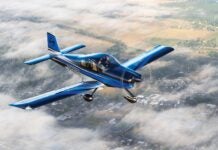If there is anything I’ve learned this year, it is this: The aviation stuff we do can be a little pricey. We’ve been breaking in an engine on a new airplane this past spring, and the fuel bill just arrived the other day. I sat down to read it. Good thing, because the number inside had me swoon. During an engine break-in period it is important that you run the engine hard and fast, and to counter the effect of all that combustion you have to leave the fuel full on, pushing lots and lots of avgas through the engine to burn and carry away the heat.
The good news is that this tried and true technique quickly seats the rings in the pistons and reduces oil consumption, and before you know it you have a fine, strong engine to fly behind for years to come. Well, if you can afford it.
Affordability is the very reason that my husband, with a little help from me, built this new airplane. We even built up the engine with low-compression cylinders that will allow us to switch to car gas if avgas becomes scarce, or far too expensive to burn. So far, though, car gas is keeping pretty good pace with avgas in its unprecedented inflation.
The RV-10, painstakingly riveted and sanded and carefully assembled with as much new, clean technology as we could afford over nearly four years, will help us continue to afford to fly for the next 20 years, we hope. It doesn’t have an electric engine, and it’s not a glider, but it is a fast, fairly heavy-lifting long-hauler for our family. And it will cost less to fly, eventually.
So what’s my advice for cutting your costs in aviation without cutting corners? Upgrade to leaner and greener flying machines, of course. If you fly a weight-shift Light Sport Aircraft, consider the possibility of using an electric engine. Randall Fishman won Grand Champion at AirVenture 2007 with his flying design, and he promises to be back with an electrically driven motorglider this year. Sonex has also promised a true electric engine in a motorglider. And IndUS Aviation recently unveiled its Thorpedo, flying with a WAM turbocharged diesel engine, which puts out 120 hp on a measly 3 gph of jet A fuel.
Consider this, too. Collaborate and use your networking skills as a catalyst for developing new ideas about how to green up your aviation habit. Meet at events such as AirVenture or AOPA’s Expo and, of course, at your local airport events. Talk about how your business is recycling, ride-sharing, and/or tuning its equipment for maximum efficiency. Are you using new technologies? Is there someone who can teach you how to do so? Group events are great opportunities for creative learning that can be individually applied. Besides, fly-in get-togethers are always great fun, too.
Catch up with me at EAA AirVenture, and we’ll brainstorm about what we’ve learned there. I’ll see you ’round the patch soon!













